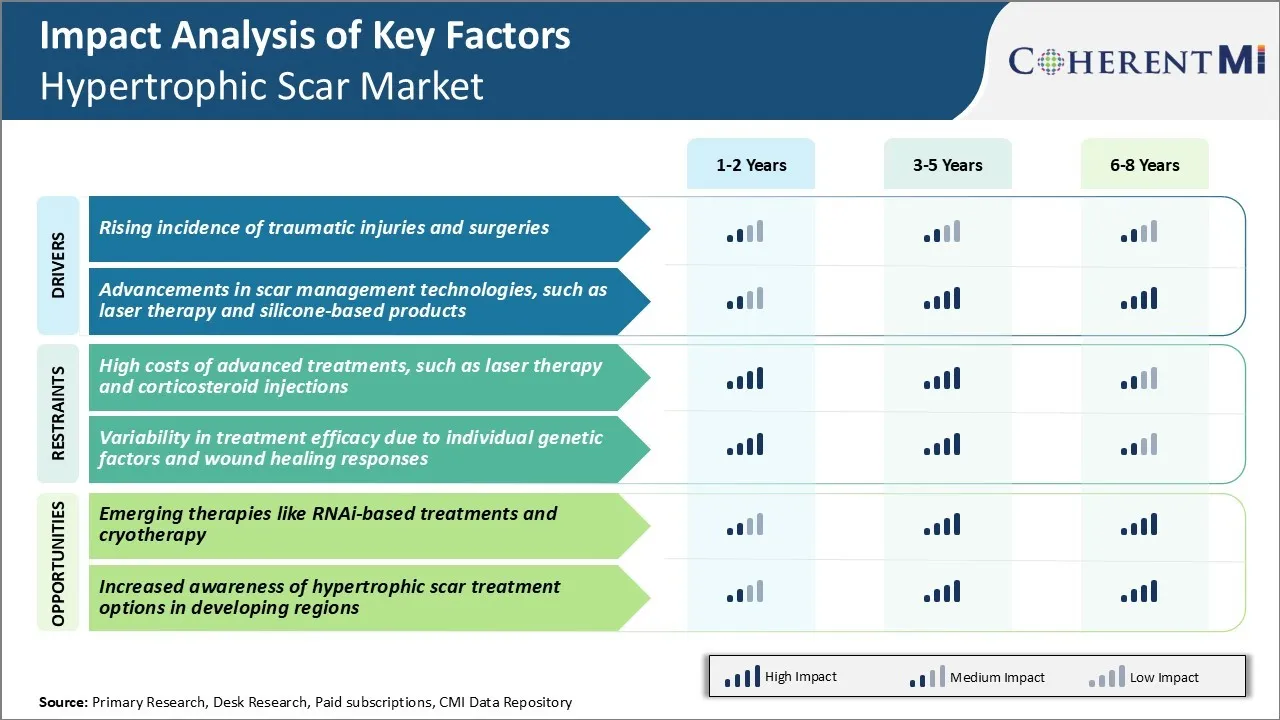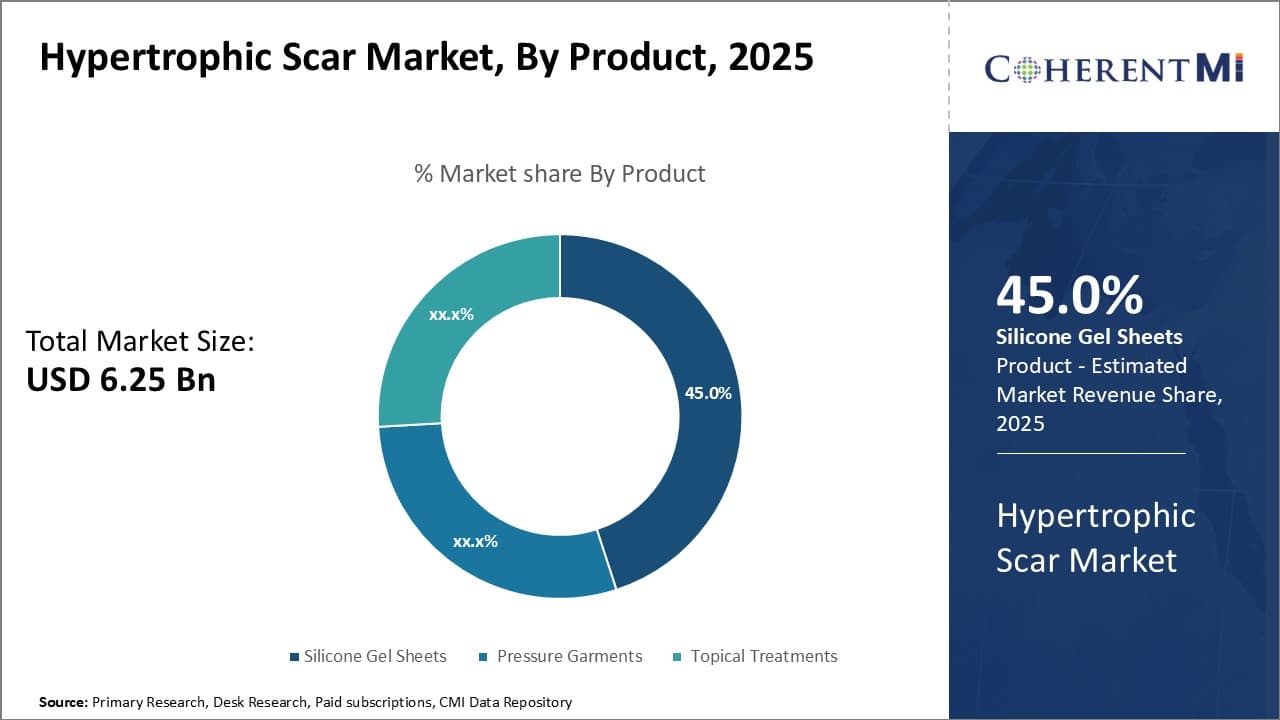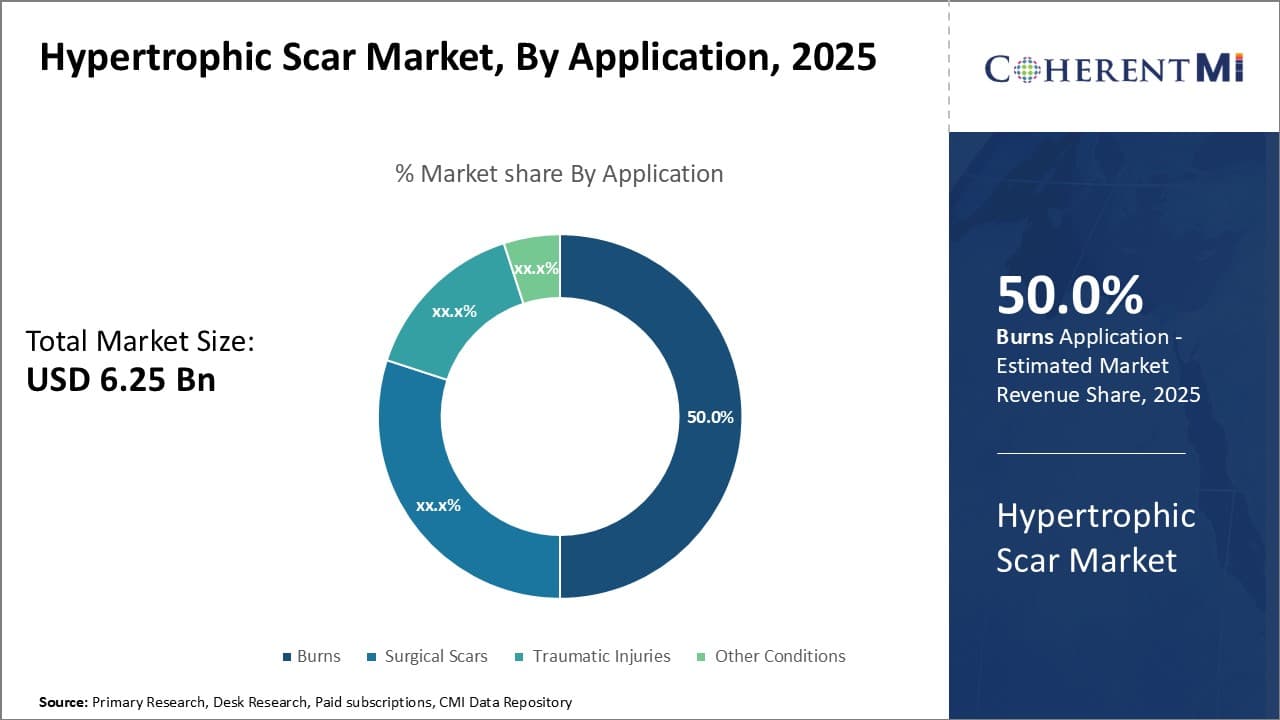

The hypertrophic scar market is estimated to be valued at USD 6.25 Bn in 2025 and is expected to reach USD 9.84 Bn by 2032, growing at a compound annual growth rate (CAGR) of 6.7% from 2025 to 2032. The market has been witnessing steady growth over the years primarily driven by rising incidences of burn injuries and surgeries. Advancements in tissue engineering approaches and technologies for effective scar treatment have further increased demand.
Market Size in USD Bn
CAGR6.7%
| Study Period | 2025-2032 |
| Base Year of Estimation | 2024 |
| CAGR | 6.7% |
| Market Concentration | Medium |
| Major Players | Smith & Nephew plc, 3M Company, Medline Industries, Inc., ConvaTec Group plc, Mölnlycke Health Care AB and Among Others |
Market Driver - Rising Incidence of Traumatic Injuries and Surgeries
According to data, around 1.35 million people die each year as a result of road traffic crashes. Injuries sustained in such accidents often require extensive wound management and skin grafting procedures subsequently increasing the risk of scarring and hypertrophic scar formation.
Similarly, burns injuries have also risen considerably with growing adoption of unsafe practices and lack of safety protocols especially in developing regions. Severe burns mostly ending up in disfiguration and scarring issues demand effective treatment and management solutions to address hypertrophic scars.
On the surgical front, the steadily increasing global healthcare spending has ensured greater access to essential as well as elective surgical procedures for populations worldwide. While surgery plays an important role in improving quality of life, associated risks such as incision site hypertrophic scarring continue to remain high. Even routine surgeries for conditions like appendix, hernia and tonsil often leave behind raised or thickened scars.
Growing caseloads of complex reconstructive and cosmetic surgeries including breast reduction and tummy tucks are further contributing to scar issues. This has significantly raised incidences of resultant pathologic scarring disorders and augmented demand for effective scar management solutions in recent times.
Market Driver - Advancements in Scar Management Technologies, such as Laser Therapy and Silicone-based Products
Another major factor driving growth in the hypertrophic scar market is the technological advancements and rising adoption of innovative scar management modalities. Companies are continuously investing in R&D to develop more efficacious and safe treatment options for scarring disorders. Laser therapy is gaining widespread acceptance owing to benefits such as minimal invasiveness, faster recovery times and ability to target scars of any shape or size including post-surgical linear hypertrophic scars.
On similar lines, novel silicone-based scar treatment formulations have emerged as an effective non-invasive alternative to laser treatments. Further, combination therapies leveraging synergies between laser and topical silicone are proving highly beneficial in scar revision applications. Overall, continual upgradation of existing technologies along with introduction of hybrid scar management protocols is positively impacting penetration of specialty scar products.
Growing patient awareness about innovative solutions along with supportive clinical research data further amplifies acceptance and uptake of advanced scar management modalities among populace and healthcare providers alike. Their ability to deliver superior cosmetic and functional improvement encourages hypertrophic scar patients to complete prescribed treatment regimens as well as seek early intervention. This augurs well for the revenue prospects of hypertrophic scar market.
 To learn more about this report, Download Free Sample Copy
To learn more about this report, Download Free Sample Copy
Market Challenge - High Costs of Advanced Treatments, such as Laser Therapy and Corticosteroid Injections
One of the key challenges faced by the hypertrophic scar market is the high costs associated with advanced treatments such as laser therapy and corticosteroid injections. These sophisticated treatment modalities often require specialized equipment and medical expertise to administer, driving up the direct costs per treatment significantly. Laser therapy involves the use of precise lasers and complex techniques to target scar tissues, which translates to expensive laser devices and lengthy, multi-session treatments for patients.
On the other hand, corticosteroid injections deploy high-dosage steroids directly into scar tissues via small needles under medical supervision. While effective at reducing scarring, repeated injections drive up treatment costs considerably over time. These high price tags pose affordability challenges for both private patients as well as medical insurers.
This cost barrier could deter patients from undergoing the full recommended course of treatments needed to achieve optimal scar reduction outcomes. It may also limit insurer coverage and reimbursement support for such specialty scar treatments. High therapy expenses could impede stronger market growth if left unaddressed.
Market Opportunity - Emerging Therapies like RNAi-based Treatments and Cryotherapy
The hypertrophic scar market presents opportunities arising from new therapeutic technologies on the horizon. One such promising approach is RNA interference (RNAi)-based treatments that target scar-promoting genes. Early research indicates short interfering RNAs (siRNAs) may help downregulate genes responsible for uncontrolled extracellular matrix deposition during scarring. siRNA gels and nanoparticles delivered locally to scars offer hope as a precisely tailored, non-steroidal option.
Additionally, minimally-invasive cryotherapy using controlled cooling is being explored. Carefully monitored, multiple short freezing cycles may calm inflammation and help scar tissues remodel more naturally over time. These emerging alternatives could address current treatment gaps. If ongoing studies bear fruit, RNAi medicines and cryotherapy present opportunities for novel, effective and relatively affordable therapy options to be commercialized in the future, serving to boost the market prospects.
Hypertrophic scarring is typically treated through a multi-staged approach. For mild cases in the early proliferative stage, prescribers commonly recommend low-to-mid potency topical corticosteroids such as mometasone furoate (Elocon) cream or lotion applied twice daily. If signs of inflammation persist after 4-6 weeks, a second-line option includes silicone gel sheeting (e.g. ScarAway gel sheets) worn for at least 12 hours per day.
For more raised or mature scars, prescribers may initially prescribe intralesional corticosteroid injections containing medications like triamcinolone acetonide (Kenalog). Typically, five treatments spaced 4 weeks apart are needed. If scarring remains elevated after initial injections, many physicians will prescribe medium-depth dermabrasion or laser resurfacing treatments using devices like fractional CO2 or erbium lasers.
Finally, for severe hypertrophic scarring or keloid lesions that do not respond to other therapies, prescribers often consider surgical excision as a last resort treatment. For recalcitrant cases, adjuvant therapies like postoperative radiotherapy, vitamin E, interferon, or mitomycin C have also shown promise but with limited evidence. Overall treatmentlength varies greatly by individualFactors like scar size, location and degree of inflammation/maturity influence prescribers' treatment selection at each stage.
Hypertrophic scars can be classified into three stages based on their appearance and severity – early, mature and late. The treatment approach differs for each stage.
In the early stage (3-12 months post injury), the scars are red and raised. Topical corticosteroid creams containing medications like Kenalog or Triderm are generally prescribed. They help reduce swelling and irritation. Silicone gel sheeting like ScarAway is also used, which softens scars over time.
As the scar matures (1-2 years), it becomes thicker and raised. Intralesional corticosteroid injections directly into the scar tissue using drugs like Kenalog or Triessence are effective. They work by reducing inflammation and hastening scar maturation. Combination therapy using steroid injections along with laser treatments such as Pulsed Dye Laser is preferred as lasers also improve texture and color.
In the late stage (over 2 years), the scars are hardened and stable. By this point, surgical revision may be needed. Scar revision procedures using techniques like Z-plasty help reshape and flatten hypertrophic tissue. For resistant cases, 5-fluorouracil injections are sometimes used before surgery for maximum outcomes.
Topical agents are preferred early on due to their non-invasive nature. As scars mature, interventional approaches work better due to deeper tissue involvement. Combination therapies give optimal results by targeting scars through different mechanisms of action.
Product Innovation: Developing innovative scar treatment products has helped companies gain an edge in this market. For example, Smith & Nephew launched its Silicone Scar Sheet in 2015, which is an advanced scar management product designed to flatten and soften scars. Clinical studies showed the product helped reduce the height and appearance of scars by over 40% in 4-6 months.
Targeted Marketing: Players focus on creating disease awareness and marketing directly to dermatologists, plastic surgeons and patients through various programs. For example, Merz holds "Scar Academy" educational conferences where experts provide insights on scar etiology and latest treatment approaches.
Strategic Partnerships: Companies partner with leading hospitals, scar clinics and researchers to gain credibility and access to patients. For instance, Perrigo partnered with Scar Clinic Netherlands in 2015 to conduct clinical trials for its scar treatment products. Such partnerships provide third-party validation of product efficacy and help expand market reach.
Geographic Expansion: Market leaders expand into high-growth international markets like Asia Pacific to tap new revenue streams. For example, Suneva Medical entered China in 2018 through an exclusive distribution agreement, opening opportunities in that region's fast-growing scar management sector.
 To learn more about this report, Download Free Sample Copy
To learn more about this report, Download Free Sample Copy
Insights, By Product: Efficacy and Comfort Drive Demand for Silicone Gel Sheets
In terms of product, silicone gel sheets are estimated to account for 45% share of the market in 2025, owning to its proven efficacy and comfort. Clinical studies have consistently shown that silicone gel sheets are the most effective treatment option for reducing both the depth and appearance of hypertrophic scars.
Unlike other products, silicone gel sheets apply a continuous pressure that mimics the pressure created during massage therapy. This continuous pressure has been demonstrated to inhibit excessive collagen production and promote scar remodeling.
Additionally, silicone gel sheets do not irritate skin like other treatments and can be worn comfortably for the recommended 12-23 hours per day. Their smooth, breathable texture prevents itching, discomfort, and scratching of scars which can worsen scarring. The ease of use and adherence to daily activities have led to greater compliance compared to other products like pressure garments which require more effort.
The convenient gel sheet form factor that contours smoothly to any body part has made it popular for scars on all areas of the body. Overall, silicone gel sheets are valued for delivering consistent, non-intrusive scar therapy without sacrificing convenience and comfort, driving their leading market position.
 To learn more about this report, Download Free Sample Copy
Insights, By Application: Treatment of Burn Injuries Drives Adoption of Compression Products
To learn more about this report, Download Free Sample Copy
Insights, By Application: Treatment of Burn Injuries Drives Adoption of Compression Products
In terms of application, scars due to burns are espected to account for 50% share of the market in 2025, due to the extent of scarring and specialized treatment needs of burn injuries. Burn scars are at the highest risk of developing into hypertrophic or keloid scars given the depth and surface area often involved.
Compared to other forms of scarring, burns also have higher needs for scar management from the initial healing stages itself to prevent complications down the line. Compression products like pressure garments, compression bandages and elastic bandages play a vital role in the multidisciplinary treatment of burn scars. These products work to mitigate excessive collagen deposition, control edema, and minimize expansion of scarring.
They are commonly used alongside other modalities like pressure therapy and silicone gel sheets. The ability to apply uniform graduated compression and customize fit makes these products invaluable for managing irregularly shaped burn scars over large surface areas. Their continuous compressive forces are also effective for controlling pruritus.
Hospitals have adopted compression garments as standard post-burn care to optimize outcomes and lower the chance of adverse scarring. This drives the leading demand from burn application.
Insights, By Distribution Channel: Hospitals at the Forefront of Hypertrophic Scar Treatment
In terms of distribution channel, hospitals contribute the highest share of the market given their critical role in hypertrophic scar management. Many scar treatments require specialized application techniques, long-term use, or are used in adjunct with other modalities like compression therapy or surgery. Due to this, hypertrophic scar patients receive a bulk of their medical care and product supplies from hospitals during the active treatment phase.
Hospitals employ trained scar specialists, physiotherapists and nurses who can properly fit, apply and monitor usage of different products. They also offer multi-disciplinary management with inputs from plastic surgeons as needed. This enables tailored, coordinated treatment plans and regular follow-ups essential for achieving optimal scar remodeling outcomes.
Hospitals also stock a wide formulary of different scar treatment options from which specialists can select the most appropriate solution based on each patient's scar characteristics and needs. Outpatient education on scar management is another value-add offered at hospitals to support long-term compliance. Overall, hospitals are the preferred first point of care for hypertrophic scar patients given their clinical expertise and resources to administer comprehensive therapeutic regimens from the start.
The major players operating in the hypertrophic scar market include Smith & Nephew plc, 3M Company, Medline Industries, Inc., ConvaTec Group plc and Mölnlycke Health Care AB.
Would you like to explore the option of buying individual sections of this report?
Vipul Patil is a dynamic management consultant with 6 years of dedicated experience in the pharmaceutical industry. Known for his analytical acumen and strategic insight, Vipul has successfully partnered with pharmaceutical companies to enhance operational efficiency, cross broader expansion, and navigate the complexities of distribution in markets with high revenue potential.
Hypertrophic Scar Market is segmented By Product (Silicone Gel Sheets, Pressure Garments, Topical Tr...
Hypertrophic Scar Market
How big is the hypertrophic scar market?
The hypertrophic scar market is estimated to be valued at USD 6.25 Bn in 2025 and is expected to reach USD 9.84 Bn by 2032.
What are the key factors hampering the growth of the hypertrophic scar market?
High costs of advanced treatments, such as laser therapy and corticosteroid injections, and variability in treatment efficacy due to individual genetic factors and wound healing responses, are the major factors hampering the growth of the hypertrophic scar market.
What are the major factors driving the hypertrophic scar market growth?
Rising incidence of traumatic injuries and surgeries and advancements in scar management technologies, such as laser therapy and silicone-based products are the major factors driving the hypertrophic scar market.
Which is the leading product in the hypertrophic scar market?
The leading product segment is silicone gel sheets.
Which are the major players operating in the hypertrophic scar market?
Smith & Nephew plc, 3M Company, Medline Industries, Inc., ConvaTec Group plc, and Mölnlycke Health Care AB are the major players.
What will be the CAGR of the hypertrophic scar market?
The CAGR of the hypertrophic scar market is projected to be 6.7% from 2025-2032.